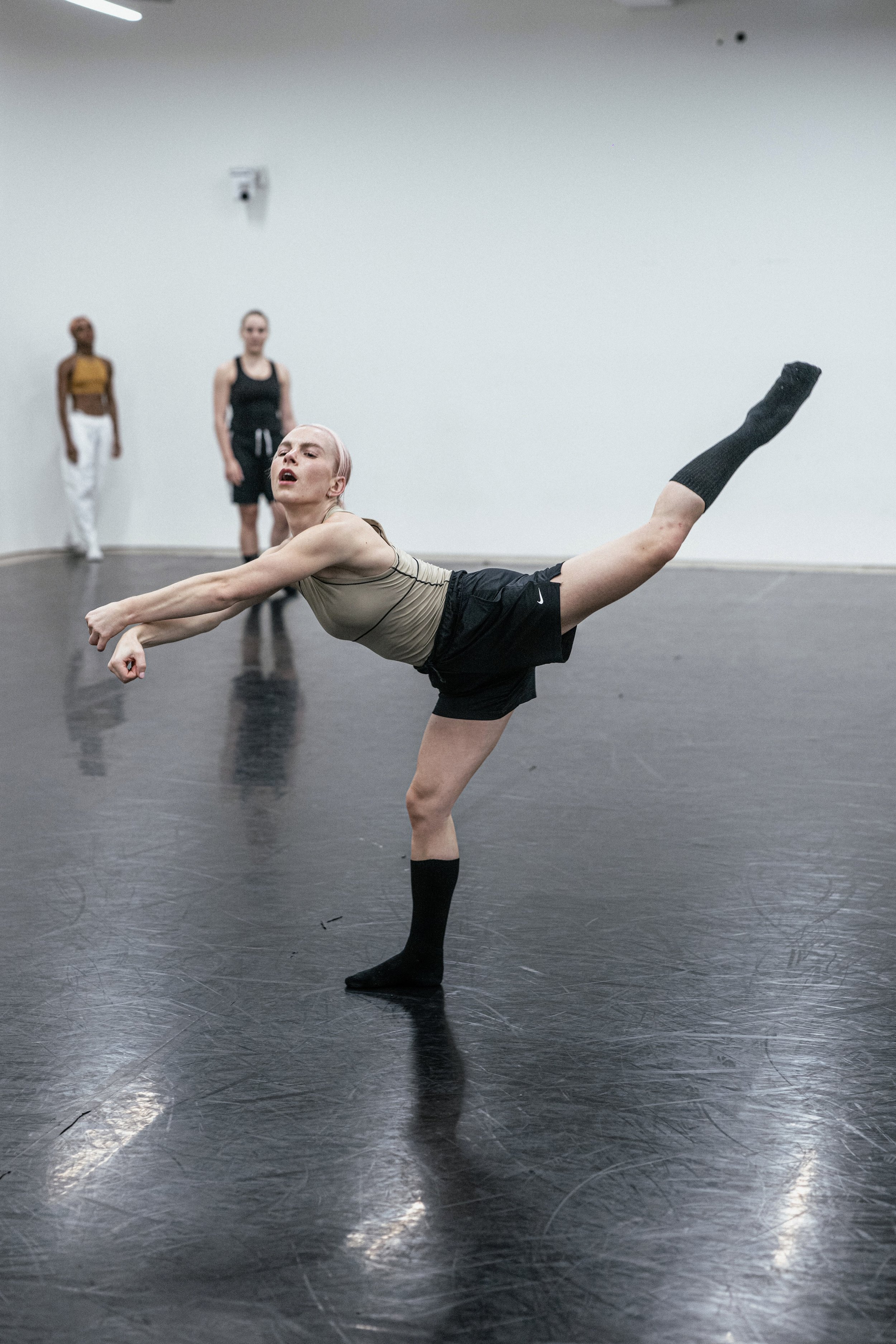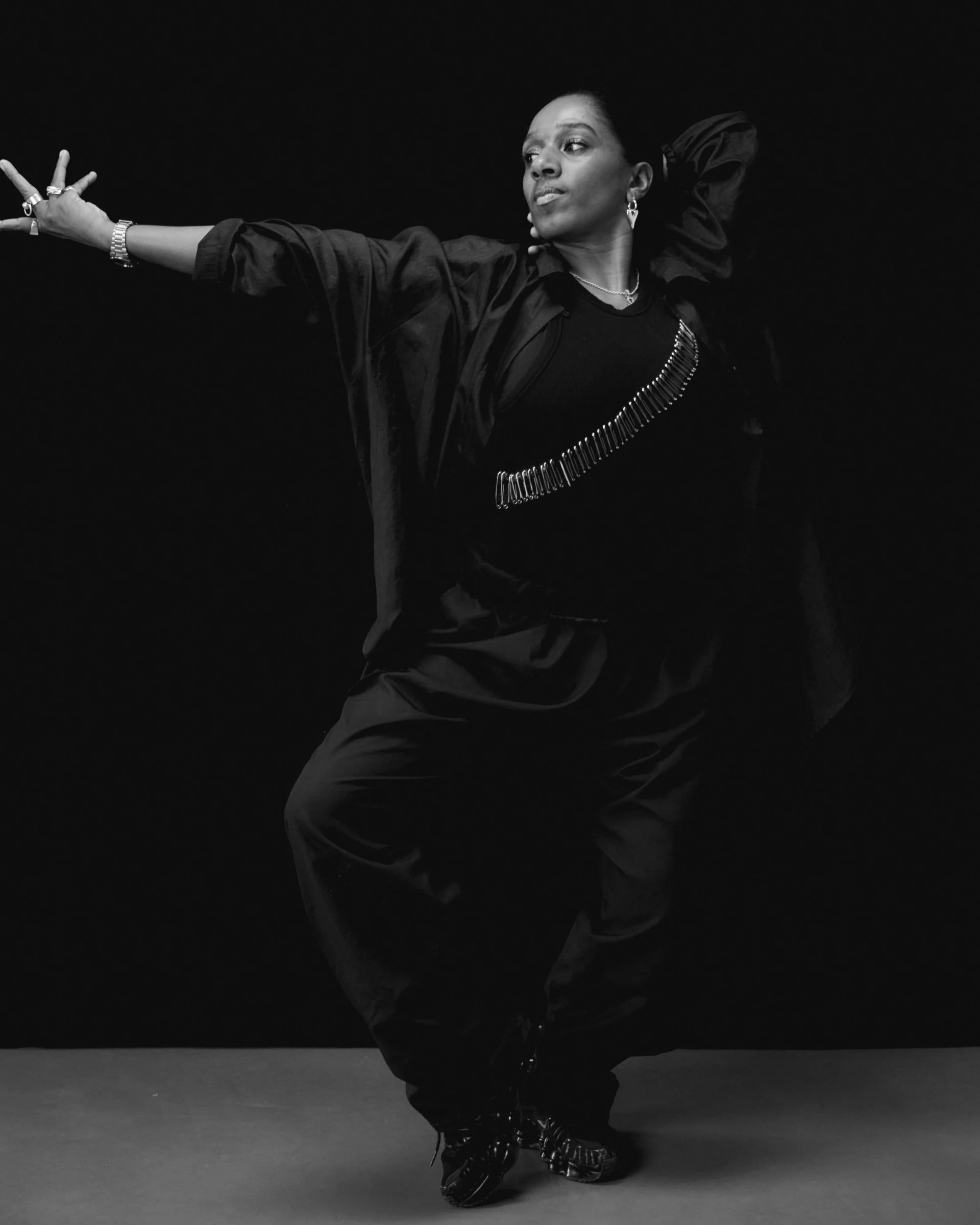On representation, community, and her love of choreography:
Charlotte Edmonds
Words MIRANNE WATLEY | Hero Image CAMILLA GREENWELL |
“It’s a tiny community and being a part of it, celebrating each other, is what keeps the passion alive,”
Staying late in the studio after classes and getting valuable opportunities to choreograph throughout the year (for example, a big summer project with Yolande Yorke-Edgell of The Yorke Dance Project), for Charlotte Edmonds full-time dance training meant realising a passion for choreography. After graduating, Charlotte began a choreography residency with The Royal Ballet and, since then, has worked on major projects both nationally and internationally (Nike, Lola Young, Bayerisches Staatsballett, Dutch National Ballet - the list is endless). With both classical and contemporary training from The Royal Ballet School and Rambert School, Charlotte’s work sits, as she puts it, “somewhere between mainstream and experimental” movement.
Alongside her dedication to dance is a love of film. Short films combining her creative vision with intricate and captivating choreography are a staple of Charlotte’s style. And, throughout her career, she has been able to combine this cinematic flair with socially relevant themes. For example, working with Louis-Jack and Francesca Hayward, Charlotte created the underwater short film, Sink or Swim - a visual manifestation of depression. A glance at her Instagram also highlights Goldfish, another short film choreographed by Charlotte using dance to depict sensory overload. Her confrontations of these issues are executed beautifully with a combination of flawless technique and avant-garde shapes. Her audiences (me) are repeatedly left in awe.
In 2023, Charlotte released the first installment of her spotlight series, Cameo, carrying her passion for film across from fictional world building to biographical interviews. With the aim to platform female and non-binary dance artists, Cameo takes us behind the scenes of these artists’ careers and discusses the unique challenges they face. It reads as a celebration of their work as Charlotte highlights their professional milestones while carefully touching on the more vulnerable demands of the dance industry. Series One featured Holly Blakey, Jules Cunningham, and Julia Cheng and Series Two, with Eve Stainton, Blue Makwana, and Chandenie Gobardhan, was released this September.
At the core of Cameo is community. The community of the choreographers it features. And the community of the audience, as the series brings together anyone and everyone interested in making the arts a more inclusive space.
MOVES was lucky enough to get the chance to talk to Charlotte about where she sees herself, and her work, fitting into this community, and how she found her way through it as an emerging artist. “Just know you can’t please everyone. I struggled with that at first. But some of the most powerful work arrives before the world is ready for it.”
Charlotte with Edwin Louis on set of Goldfish - By Camilla Greenwell
In 2023, Charlotte released the first installment of her spotlight series, Cameo, carrying her passion for film across from fictional world building to biographical interviews. With the aim to platform female and non-binary dance artists, Cameo takes us behind the scenes of these artists’ careers and discusses the unique challenges they face. It reads as a celebration of their work as Charlotte highlights their professional milestones while carefully touching on the more vulnerable demands of the dance industry. Series One featured Holly Blakey, Jules Cunningham, and Julia Cheng and Series Two, with Eve Stainton, Blue Makwana, and Chandenie Gobardhan, was released this September.
At the core of Cameo is community. The community of the choreographers it features. And the community of the audience, as the series brings together anyone and everyone interested in making the arts a more inclusive space.
MOVES was lucky enough to get the chance to talk to Charlotte about where she sees herself, and her work, fitting into this community, and how she found her way through it as an emerging artist. “Just know you can’t please everyone. I struggled with that at first. But some of the most powerful work arrives before the world is ready for it.”
Can you introduce yourself?
I’m a choreographer and director. My work lives somewhere between mainstream and experimental. I started out in classical ballet before veering into something a bit more transgressive. And I’m completely obsessed with choreography - it’s my true love.
What advice would you give to other dancers trying to discover their individual style of choreography?
About two years into calling myself a choreographer, I remember asking the legendary choreographer, Robert Cohan, ‘But how do you actually find your voice?’ And he just laughed. At the time, it felt disconcerting. But now I get it. It’s a bit like a ten-year-old wanting to grow up fast and demanding to go clubbing - you might have the enthusiasm, but you also need the hideous teenage years.
All the awkwardness and brutal lessons are where you start to shape a real voice. Now, in my late 20s, that voice feels more assured, formed and recognisable. But Robert was right, it takes years.
What is one lesson you learned that changed your work?
Know what’s possible within the commission or rehearsal time you have - be realistic. People connect more with short, well-executed ideas than with a flood of concepts that lack clear direction. Overcomplicating can dilute your message, I’ve learnt that the hard way.
“And risk? Take it... But take it with awareness. Know when and where to push boundaries. Courage paired with intention has more impact.”
Images shot by Jack Thomson
Can you describe what it’s like working with large brands such as Spotify, Burberry and Soho House?
They are all such different experiences. People say ‘stick to the one thing you’re good at’, but I’m here to try it all. Nike x Spotify was an amazing campaign to work on. The creative direction focused on teenage girls, mental health, and how music and movement can kick us into a better headspace. It was a true choreography and movement-direction hybrid.
Burberry was also incredible. I came on board to support casting and wire-work development for the choreography. The dancers were flying between huge trees out on location, so I loved seeing what was possible. And it was a total dream to work with the directors, Megaforce.
For Soho House, I curate events like screenings and panel talks, which is fantastic because I love spotlighting female and non-binary creatives.
How do these jobs differ from your personal projects, for example, Goldfish?
The personal projects take much longer to develop. They are also where you have the freedom to fully project your vision - how you want your work to look and feel. And they’re a chance to work with creatives you’ve had on your radar.
When did you begin to include more socially relevant themes in your work?
They’ve always been there, but I’ve just become braver about exploring them. For me, if a piece doesn’t hit you or challenge you in some way it feels like a missed opportunity.
Cameo stills shot by Maite de Orbe
Can you describe Cameo?
Cameo is a digital series that amplifies female and non-binary dance artists. It’s a platform for visibility and aims to spark change. Series One and Two have launched with Nowness and feature interviews from Julie Cunningham, Holly Blakey, Julia Cheng, Eve Stainton, Blue Makwana and Chandenie Gobardhan. The conversations offer guidance on navigating the highs and lows of a dance career in the current landscape... and they foster a community. Cameo was born from the challenge of navigating spaces that often feel inaccessible.
How did you select the artists for the most recent series of Cameo?
I’m fortunate enough to be in touch with so many incredible artists, which makes curating it down to just three for each series so tough. But it’s also exciting for the longevity of Cameo. Series Two focuses on both emerging and mid-scale artists as I think these are some of the toughest (yet most pivotal) moments in a creative career.
Why did you decide to exclusively focus on women and non-binary artists?
There’s an imbalance of opportunity. Over the last 100 years, there have been only six female Artistic Directors in the top five UK dance companies. Out of these, two of them founded the companies themselves. Today, there are none at all. The goal is to see more female and non-binary artists in leadership positions, and to ensure they have access to the skills, networks, and opportunities needed to step into those roles.
Also, when I started out, I would have loved the chance to sit down with female artists I admired and hear how they navigated the same difficulties I was experiencing, so this is my way of advocating for positive change.
How has recording Cameo impacted the way you approach gender dynamics in your work?
I’ve always considered myself a socially conscious artist, but working on Cameo has reinforced the importance of inclusivity. Making sure collaborators are thoughtfully considered at every stage. When it comes to the choreography itself, I enjoy challenging traditional gender norms and moving beyond the classical duets I grew up learning. That said, I still love creating duets between male and female dancers, but the difference now is that the language of the choreography may shift - reflecting a more fluid and conscious approach to gender dynamics.
That said, I still love creating duets between male and female dancers, but the difference now is that the language of the choreography may shift - reflecting a more fluid and conscious approach to gender dynamics.
Do you feel that gender dynamics have impacted your own professional opportunities?
This is a tough one because it’s not a simple yes or no. There have been situations where I’d say yes, and others where it’s been less relevant or even an advantage. Looking back to when I was a teen-ish woman, I had the privilege of being in boardrooms or spaces with people of influence. That said, it was those moments where I felt out of place, dismissed, or just plain ignored which really dented my confidence and, by extension, my professional opportunities. I’m not always sure whether that came down to gender, age, or experience... but it was probably a mix of all three!
Charlotte Edmonds by Camilla Greenwell
Whose career are you most inspired by?
To be honest, I’m most inspired by the people who haven’t always been recognised for their efforts. The ones who are unflinchingly caring and honest off screen. If I had to name someone, I think Lynne Ramsay is very inspiring. I love how she just sticks to her guns.
How do you keep your joy in dancing when it’s also your job?
Today someone sent me a piece of music to choreograph to and, with the link, wrote ‘It feels very you - quite sensual, quite abstract’. That sense of connection is what keeps me inspired. I also make a point of seeing other people’s work. It’s a tiny community and being part of it, celebrating each other, is what keeps the passion alive.









